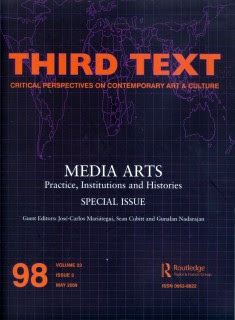Third Text, 98: Media Arts: Practice, Institutions and Histories (2009)
Filed under journal | Tags: · art, electronic art, media art, postcolonialism, video art, visual culture

Special issue of Third Text journal is an update on the development and current state of new media arts in some “under-represented” regions and contexts of the world, from New Zealand to India and from South Africa to the former East of Europe.
Guest Editors: Sean Cubitt, Jose-Carlos Mariategui and Gunalan Nadarajan.
Contributions by Nina Czegledy and Andrea Szekeres, Olga Goriunova, Pi Li, Marcus Neustetter, Ravi Sundaram and others.
Publisher Third Text, May 2009
ISSN: 1475-5297 (electronic) 0952-8822 (paper)
PDF (updated on 2016-4-16)
Comments (2)Bernard Stiegler: Technics and Time, 1: The Fault of Epimetheus (1994–) [EN, ES]
Filed under book | Tags: · anthropology, metaphysics, ontology, philosophy, technical object, technics, technoscience, time

“What is a technical object? At the beginning of Western philosophy, Aristotle contrasted beings formed by nature, which had within themselves a beginning of movement and rest, and man-made objects, which did not have the source of their own production within themselves. This book, the first of three volumes, revises the Aristotelian argument and develops an innovative assessment whereby the technical object can be seen as having an essential, distinct temporality and dynamics of its own.
The Aristotelian concept persisted, in one form or another, until Marx, who conceived of the possibility of an evolution of technics. Lodged between mechanics and biology, a technical entity became a complex of heterogeneous forces. In a parallel development, while industrialization was in the process of overthrowing the contemporary order of knowledge as well as contemporary social organization, technology was acquiring a new place in philosophical questioning. Philosophy was for the first time faced with a world in which technical expansion was so widespread that science was becoming more and more subject to the field of instrumentality, with its ends determined by the imperatives of economic struggle or war, and with its epistemic status changing accordingly. The power that emerged from this new relation was unleashed in the course of the two world wars.
Working his way through the history of the Aristotelian assessment of technics, the author engages the ideas of a wide range of thinkers—Rousseau, Husserl, and Heidegger, the paleo-ontologist Leroi-Gourhan, the anthropologists Vernant and Detienne, the sociologists Weber and Habermas, and the systems analysts Maturana and Varela.”
Originally published in French under the title La Technique et le temps. Vol. 1: La faute d’Epiméthée, 1994.
English edition
Translated by Richard Beardsworth and George Collins
Publisher Stanford University Press, 1998
ISBN 0804730415, 9780804730419
316 pages
Technics and Time 1: The Fault of Epimetheus (English, 1998, updated on 2012-7-19)
La tecnica y el tiempo, I. El Pecado de Epimeteo (Spanish, updated on 2012-7-19)
Mitchell Whitelaw: Metacreation: Art and Artificial Life (2004)
Filed under book | Tags: · aesthetics, artificial intelligence, artificial life, cellular automata, genome, interactivity, simulation

“Artificial life, or a-life, is an interdisciplinary science focused on artificial systems that mimic the properties of living systems. In the 1990s, new media artists began appropriating and adapting the techniques of a-life science to create a-life art; Mitchell Whitelaw’s Metacreation is the first detailed critical account of this new field of creative practice.
A-life art responds to the increasing technologization of living matter by creating works that seem to mutate, evolve, and respond with a life of their own. Pursuing a-life’s promise of emergence, these artists produce not only artworks, but generative and creative processes: here creation becomes metacreation.
Whitelaw presents a-life art practice through four of its characteristic techniques and tendencies. “Breeders” use artificial evolution to generate images and forms, in the process altering the artist’s creative agency. “Cybernatures” form complex, interactive systems, drawing the audience into artificial ecosystems. Other artists work in “Hardware,” adapting Rodney Brooks’s “bottom-up” robotics to create embodied autonomous agencies. The “Abstract Machines” of a-life art de-emphasize the biological analogy, using techniques such as cellular automata to investigate pattern, form and morphogenesis.
In the book’s concluding chapters, Whitelaw surveys the theoretical discourses around a-life art, before finally examining emergence, a concept central to a-life, and key, it is argued, to a-life art.”
Publisher MIT Press, 2004
ISBN 0262232340, 9780262232340
281 pages
PDF (updated on 2012-8-11)
Comment (0)
